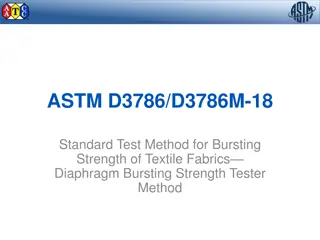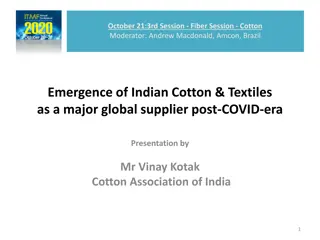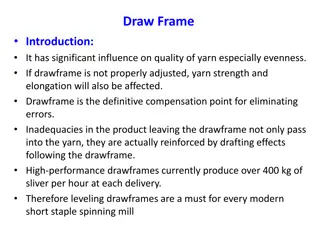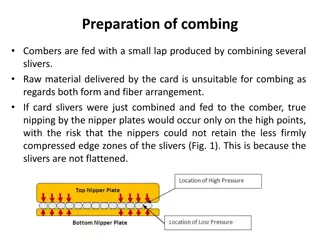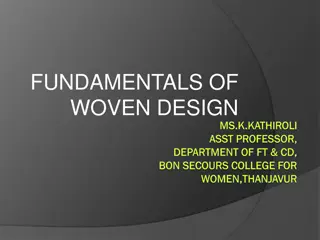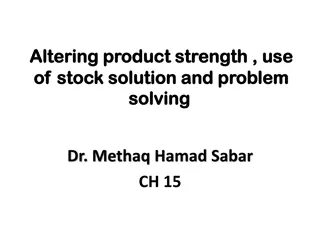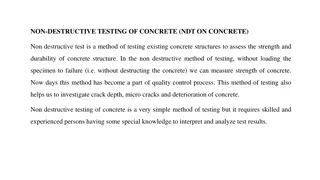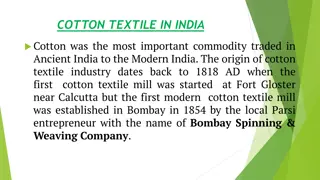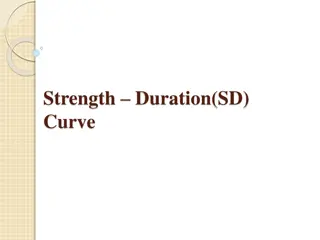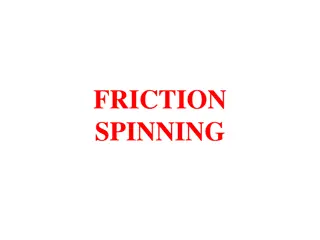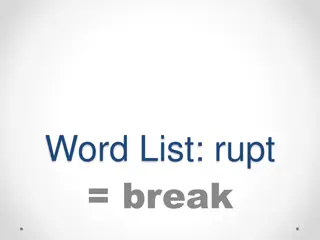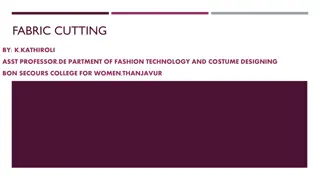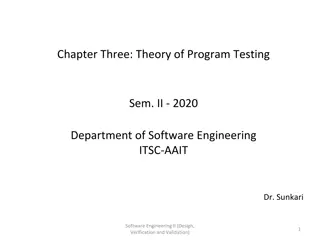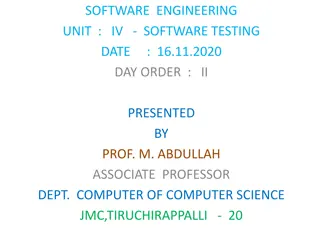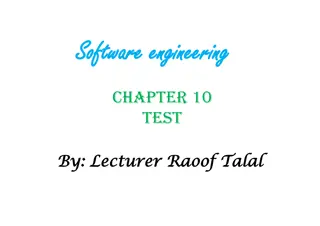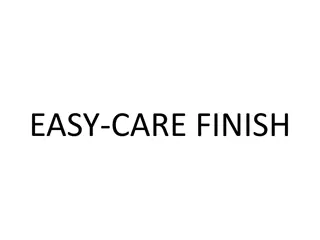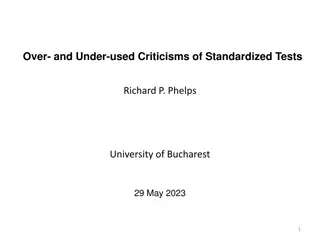Testing Methods for Textile Fabrics Breaking Strength and Elongation
Standard testing methods, ASTM D5034 and D5035, are used to determine the breaking strength and elongation of textile fabrics through grab and strip tests. The grab test measures the effective strength of fabric using adjacent yarns, while the strip test compares the strength of unwoven yarns. Apparatus, materials, tensile testing machines, conditioning requirements, and scope of testing are outlined for accurate evaluation of fabric quality.
Download Presentation

Please find below an Image/Link to download the presentation.
The content on the website is provided AS IS for your information and personal use only. It may not be sold, licensed, or shared on other websites without obtaining consent from the author. Download presentation by click this link. If you encounter any issues during the download, it is possible that the publisher has removed the file from their server.
E N D
Presentation Transcript
ASTM D5034-09 (2017) Standard Test Method for Breaking Strength and Elongation of Textile Fabrics (Grab Test) ASTM D5035-11 (2019) Standard Test Method for Breaking Force and Elongation of Textile Fabrics (Strip Method)
Definition Breaking Force: the maximum force applied to a material carried to rupture Discussion: Materials that are brittle usually rupture at the maximum force. Materials that are ductile usually experience a maximum force before rupturing. ASTM D5034 & D5035
Grab versus Strip Grab test measures effective strength of fabric (yarns in specific width, plus assistance from adjacent yarns) Quicker to prepare More fabric required per specimen Strip test can be compared to strength of equal number of unwoven yarns ASTM D5034 & D5035 GRAB STRIP
Apparatus & Materials Tensile testing machine (300 10 mm/min) Clamps and jaw faces Pins (for high-strength fabrics) For wet test: Distilled water Nonionic wetting agent (if needed) Standard fabrics (for verification) ASTM D5034 & D5035
Tensile Testing Machines CRE (Constant Rate of Extension), the pulling clamp moves at a uniform rate and the force- measuring mechanism moves a negligible distance. CRL (Constant Rate of Load), the rate of increase of force is uniform with time after the first 3 seconds and the specimen is free to elongate. CRT (Constant Rate of Traverse), the pulling clamp moves at a uniform rate and the force is applied through the other clamp which moves noticeably. ASTM D5034 & D5035
Conditioning Condition specimens according to ASTM D1776 For wet test: immerse specimens in room temperature water Use nonionic wetting agent if needed Test within two minutes of removal from water ASTM D5034 & D5035
Scope: ASTM D5034 Grab and modified grab procedures for determining breaking strength Mainly used for woven fabrics Also, nonwovens and felted fabrics NOT recommended for glass, knitted, or high- stretch (> 11%) fabrics ASTM D5034
Test Options: ASTM D5034 Type of specimen: G (Grab) MG (Modified Grab) Type of tensile testing machine: E (Constant-Rate-of-Extension/CRE) L (Constant-Rate-of-Load/CRL) T (Constant-Rate-of-Traverse/CRT) ASTM D5034 & D5035
Jaw Faces: ASTM D5034 Modified Grab Test Grab Test Direction of force Front face 25 mm (1 in) wide 25-50 mm (1-2 in) long Back face At least as large as front Front face 25 50 mm (1 2 in ) min. Longer in direction of force Back face 50 50 mm (2 2 in ) min. ASTM D5034
Specimens: ASTM D5034 Long edges parallel to the testing direction 5 specimens in warp direction 8 specimens in fill direction (if required) Cut wet testing specimens (optional) with same yarns in test direction as dry Extra specimens for time-to- break test (optional) dry 1 wet 1 ASTM D5034
Specimens: ASTM D5034 10 mm Grab Test (G) 100 1 mm (4 0.05 in) wide at least 150 mm (6 in) long (depending on jaw face size) Draw a line parallel to the long direction along a yarn for woven fabric 37 1 mm (1.5 0.02 in) from one long edge 37 mm 37 mm 25 25 mm 75 mm gage length 25 25 mm 10 mm ASTM D5034
Specimens: ASTM D5034 10 mm 50 25 mm Modified Grab Test (MG) Cut and mark as for grab Specimen must be at least 200 mm long to accommodate longer jaw faces (required for modified grab; optional for grab) Slit at midpoint, leaving 25 mm uncut 75 mm gage length 50 25 mm ASTM D5034 10 mm
Procedure: ASTM D5034 Mount the specimen in the jaws with the parallel line adjacent to the side of the upper and lower front jaw faces. The parallel line ensures the same lengthwise yarns (of woven fabrics) are gripped in both clamps and that the force application is not at an appreciable angle to the test direction of nonwoven fabrics. Tension on the specimen should be uniform across the clamp width. ASTM D5034
Procedure: ASTM D5034 ASTM D5034
Procedure: ASTM D5034 Operate the machine and break the specimen. Read the breaking force, and elongation if required. Record warp and fill direction results separately. If a specimen slips in the jaws, or breaks at or in the jaws, discard and test another specimen. ASTM D5034
Report: ASTM D5034 Test method Material tested Average breaking force of acceptable specimens for each test condition Average percent apparent elongation of acceptable specimens for each test condition and strip test (if calculated) Number of specimens tested in each direction Type of specimen and testing machine used Maximum force obtainable in the range used for testing ASTM D5034
Scope: ASTM D5035 Raveled and cut strip test procedures for determining the breaking force and elongation of most textile fabrics. Raveled strip test is applicable to woven fabrics Cut strip test is applicable to nonwoven, felted, dipped, and coated fabrics (that can not be raveled) Not recommended for knitted fabrics or for other textile fabrics which have high stretch (more than 11%). ASTM D5035
Specimens: ASTM D5035 1R: 25 mm (1.0 in.) raveled strip test 2R: 50 mm (2.0 in.) raveled strip test 1C: 25 mm (1.0 in.) cut strip test 2C: 50 mm (2.0 in.) cut strip test ASTM D5035
Specimens: ASTM D5035 Long edges parallel to the testing direction 5 specimens in warp direction 8 specimens in fill direction (if required) Cut wet testing specimens (optional) with same yarns in test direction as dry Extra specimens for time-to-break test (optional) ASTM D5034 & D5035
1R Specimens: 1 raveled strip test ASTM D5035 Width 35 mm (1.5 in) OR 25 mm (1 in) plus 20 yarns (whichever is wider) Length At least 150 mm (6 in) Longer for larger jaw faces and high-strength test with pins Remove an approximately equal number of yarns from each long edge, leaving a testing width of 25 mm ASTM D5035
2R Specimens: 2 raveled strip test ASTM D5035 Width 65 mm (2.5 in) OR 50 mm (2.0 in) plus 20 yarns (whichever is wider) Length At least 150 mm (6 in) Remove an approximately equal number of yarns from each long edge, leaving a testing width of 50 mm ASTM D5035
Cut Strip Specimens ASTM D5035 1C: 1 cut strip test 25 mm (1 in) wide At least 150 mm (6 in) long 2C: 2 cut strip test 50 mm (2 in) wide At least 150 mm (6 in) long ASTM D5035
Jaw Faces: ASTM D5035 At least 10 mm (0.5 in) wider than specimen 35 mm (1.5 in) for 1R and 1C 60 mm (2.5 in) for 2R and 2C At least 25 mm (1 in) in direction of force ASTM D5035
Procedure: ASTM D5035 Mount the specimen securely in the clamps. Make sure it is centrally located and that the long dimension is as nearly parallel as possible to the direction of force application. Operate the machine and break the specimen. Read the breaking force, and elongation if required. Record warp and fill direction results separately. If a specimen slips in the jaws, or breaks at or in the jaws, discard and test another specimen. ASTM D5035
Report: ASTM D5035 Test method (ASTM D5035-11) Material tested Average breaking force of acceptable specimens for each test condition and strip test Average percent apparent elongation of acceptable specimens for each test condition and strip test (if calculated) Number of specimens tested in each direction Type of strip test and testing machine used Maximum force obtainable in the range used for testing ASTM D5035
Report: ASTM D5035 Pretension (if any) Size of jaw faces Jaw padding or specimen modification (if any) Number of yarns in the width of the strip (if < 20) Average time required to break, if applicable, for all specimens giving acceptable breaks Condition (dry or wet) For wet specimens, note whether allowance was made for shrinkage Sizing/finish removal method (if applicable) ASTM D5035
High-Strength Fabrics Modify jaws or specimen to reduce slippage Test with pins to reduce slippage ASTM D5034 & D5035


